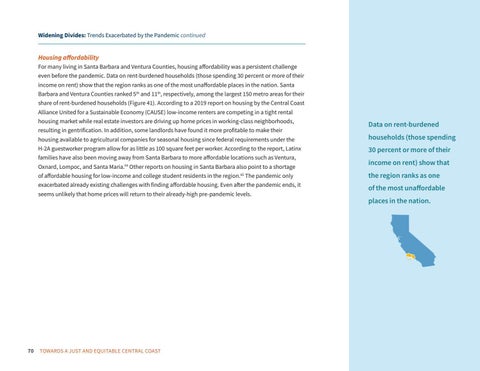Widening Divides: Trends Exacerbated by the Pandemic continued
Housing affordability For many living in Santa Barbara and Ventura Counties, housing affordability was a persistent challenge even before the pandemic. Data on rent-burdened households (those spending 30 percent or more of their income on rent) show that the region ranks as one of the most unaffordable places in the nation. Santa Barbara and Ventura Counties ranked 5th and 11th, respectively, among the largest 150 metro areas for their share of rent-burdened households (Figure 41). According to a 2019 report on housing by the Central Coast Alliance United for a Sustainable Economy (CAUSE) low-income renters are competing in a tight rental housing market while real estate investors are driving up home prices in working-class neighborhoods, resulting in gentrification. In addition, some landlords have found it more profitable to make their housing available to agricultural companies for seasonal housing since federal requirements under the H-2A guestworker program allow for as little as 100 square feet per worker. According to the report, Latinx families have also been moving away from Santa Barbara to more affordable locations such as Ventura, Oxnard, Lompoc, and Santa Maria.64 Other reports on housing in Santa Barbara also point to a shortage of affordable housing for low-income and college student residents in the region.65 The pandemic only exacerbated already existing challenges with finding affordable housing. Even after the pandemic ends, it seems unlikely that home prices will return to their already-high pre-pandemic levels.
70
TOWARDS A JUST AND EQUITABLE CENTRAL COAST
Data on rent-burdened households (those spending 30 percent or more of their income on rent) show that the region ranks as one of the most unaffordable places in the nation.
